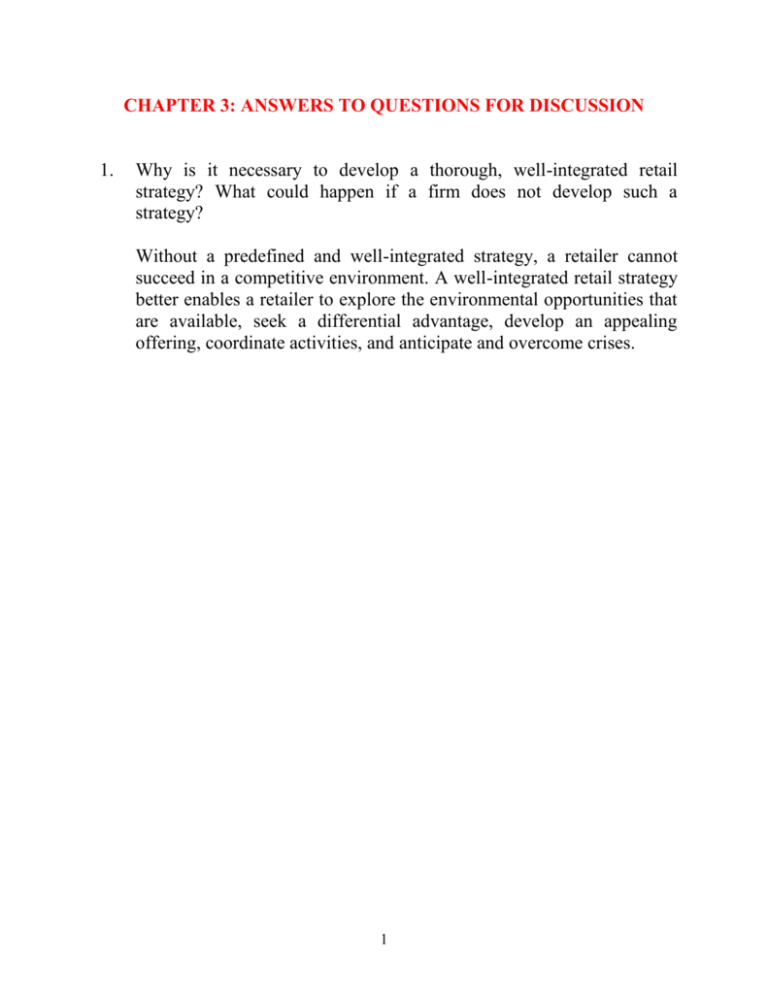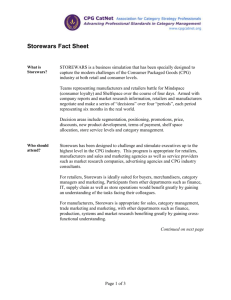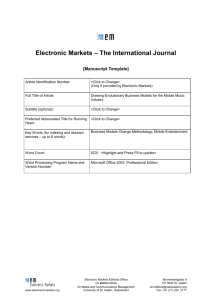CHAPTER 3: ANSWERS TO QUESTIONS FOR DISCUSSION
advertisement

CHAPTER 3: ANSWERS TO QUESTIONS FOR DISCUSSION 1. Why is it necessary to develop a thorough, well-integrated retail strategy? What could happen if a firm does not develop such a strategy? Without a predefined and well-integrated strategy, a retailer cannot succeed in a competitive environment. A well-integrated retail strategy better enables a retailer to explore the environmental opportunities that are available, seek a differential advantage, develop an appealing offering, coordinate activities, and anticipate and overcome crises. 1 2. How would situation analysis differ for a shoe store chain and an online shoe retailer? Situation analysis is the candid evaluation of the opportunities and potential problems facing a prospective or existing retailer. A shoe store chain may evaluate opportunities and problems such as increased competition from department stores, new developments affecting a large number of store units (such as increased sales of shoes to tourists in certain markets), and may explore such overall competitive advantages as free delivery, etc. The online shoe retailer should devote more attention to global influences, other Web-based competitors, delivery arrangements over longer distances, the quality and ease of use of its Web site, and pricing comparisons with other Web-based shoe retailers. The online shoe retailer may also need to explore the possibility of free return shipping due to issues with fit and color accuracy. 2 3. What are the pros and cons of starting a new hair salon versus buying an existing one? Starting a new hair salon offers a greater flexibility in location, atmosphere, and choice of consumer market. It allows a strategy to be fully tailored to the new owner’s desires and strengths. However, starting a new hair salon entails construction or renovation costs, a time lag until the store is ready to open (and then until planned sales levels and profits are earned), an unknown name and image, and the need to establish new supplier relationships. Buying an existing hair salon allows a retailer to acquire an established name, customer following, location, trained personnel, and facilities; to open faster; to generate ongoing sales and profits; and to possibly obtain good lease terms and/or financing from the seller. On the other hand, store fixtures may also be older; there is less flexibility in developing and enacting a strategy tailored to the new owner’s desires and strengths; the seller’s inventory of shampoos, hair conditioners, and nail polish may have to be purchased; and contractual obligations for alarm and other services may have to be continued. Lastly, the value of goodwill will also have to be determined. 3 4. Develop a checklist to help a prospective service retailer choose the proper service category in which to operate. Include personal abilities, financial resources, and time demands. A checklist should include the following components: Personal Abilities Aptitudes Education Experience Professional skills Credit capability Financial Resources Initial investment required Drawing account needs Renovations/construction needs Width/depth of assortment Time Demands Automation capability Delegation of work Degree of involvement desired Off-hours activities Stability vs. seasonality in sales 4 5. Why do retailers frequently underestimate the financial and time requirements of a business? Retailers often underestimate capital investments, operating expenses, merchandise costs, and, most importantly, living expenses. In addition, retailers sometimes expect immediate success and do not have the financial resources to continue in business during the time period when the firm is unprofitable. Time requirements are often underestimated because some retailers have difficulties delegating duties to employees, automation may not be possible or have limited applications, and retailers are required to work during off-hours to make purchases, keep records, etc. Many retailers do not have sufficient funds to hire additional personnel. 5 6. A competing bicycle store has a better location than yours. It is in a modern shopping center with a lot of customer traffic. Your store is in an older neighborhood and requires customers to travel further to reach you. How could you use a merchandising, pricing, and communications strategy to overcome your disadvantageous location? Merchandising decisions should be made which increase the width and depth of the goods/services assortment. A better selection of goods/services or concentration on special segments (such as mountain bicycles, bicycles for enthusiasts, three-wheel bicycles for seniors, and folding bicycles for apartment dwellers) may attract more customers. Staff should also be comprised of bicycle enthusiasts who are especially knowledgeable. The store can also offer to double the manufacturer's warranty at a low cost, and to provide a free bicycle tune-up within one year of the bicycle's purchase. 6 Prices should be lower than those of the competitor, but still allow a reasonable profit. The bicycle retailer should also match all local competitor price levels. Communications with customers can focus on the low prices, product selection, exclusive merchandise and personal service that may not be available from the competing retailer. Advertising can use slogans such as “We may be out of the way, but it’s worth the drive,” etc. 7









